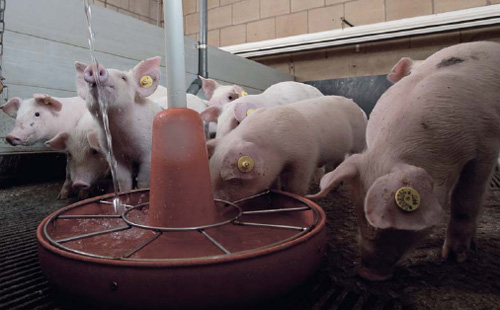A natural way to combat S. suis in piglets

Over the years, it has been possible to tackle various bacterial pig diseases through the correct use of natural feed additives. Streptococcus suis, however, has long been a different story. Two Dutch companies recently found a solution by using a product mixture.
One of the main causes of health problems and one of the reasons for using therapeutic antibiotics in rearing piglets is the occurrence of the pathogenic gram-positive bacteria Streptococcus suis. To tackle tis problem more research is needed, e.g. determining the way S. suis is spread within a herd and developing adapted feeding concepts. Several researchers found that S. suis plays an important role in the intestines where it can pass through the intestinal wall (translocation towards mesenteric lymph nodes). This means that S. suis does not only enter the blood through exterior wounds or tonsils finally leading to disease, for example meningitis. A few days after weaning, S. suis can be found at high levels in stomach and intestines and so this offers opportunities to tackle the problems through special new feeding concepts.
Animal nutrition companies Denkavit and Kemira teamed up to develop a natural way of avoiding problems with S. suis, using a product based on organic acids and their salts in combination with specific fatty acids enriched in C12:0.Using an in vitro model they showed, probably for the first time, that problems with Streptococcus suis can be tackled through a judicious use of feed additives. The fact that both pathogenic bacteria E. coli and S. suiscould be suppressed offers great opportunities to raise piglets with fewer health problems and to reduce the amount of antibiotics used in pig production.
In vitro model
In cooperation with a Scandinavian laboratory, an in vitro model was developed simulating as much as possible the stomach and small intestines of piglets. In this model several products were tested. All test products were initially treated by pepsin-HCL (pH 3-4) for one hour and by bile acids + pancreatin + NaOH (pH 6.8-7.2) for three hours at 37°C prior to introducing them in the simulation vessels. As growth medium for the simulation model, distal ileal digesta was taken from five piglets and pooled.
A buffer solution (pH 6.5) was added, the growth medium was anaerobic and the test products were added.
Finally, fresh ileal digesta of two piglets was spiked with live E. coli and S. suis bacteria and added into the simulation vessels. Each test product was applied at four dosages and with five replicates.
After an incubation for ten hours the vessels were sampled for analysis. Figures 1 and 2 show the results of the bacteria analysis. Figure 1 shows the results with regards to growth inhibition of E. coli. Moreover E. coli as percentage of the total bacteria flora was reduced significantly from approximately 9% in the negative control group to less than 1% at the highest dosages. Figure 2 shows the results of the acid combination on Streptococcus suis at higher dosages. Although even supplying an organic acid product (Denkacid) already achieved some reduction – the novel combination showed a much stronger and significant reduction of S. suis.
Organic acid mixture The product Denkavit and Kemira developed together is known as Denkacid XL. On one hand, it consists of the organic acid mixture Denkacid, based on the short chain fatty acids formic-, acetic-, propionic- and citric acid as well as calcium salts. This product is combined with extra lipophilic compounds like medium chain fatty acids (MCFA) enriched with lauric acid (C12:0). With this latter MCFA-mix Kemira also found good effects against another gram-positive bacterium, Clostridium perfringens in broilers (see AllAboutFeed 1.6). |











